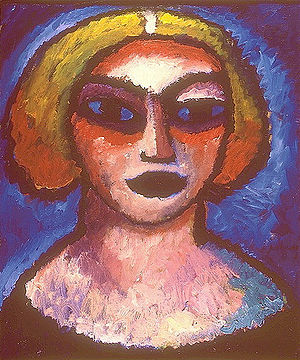Head of a woman (Jawlensky)

|
| Woman head |
|---|
| Alexej von Jawlensky , 1912 |
| Oil on cardboard |
| 61 × 51 cm |
| New National Gallery , Berlin |
Frauenkopf is the title of an expressionist painting by the German-Russian painter Alexej von Jawlensky , which was created in 1912. It has been part of the New National Gallery in Berlin since 1964 .
Description, painting technique and color
The picture is made using the technique of oil on cardboard and has the dimensions 61 × 51 cm. It bears the Nationalgalerie inventory number B 439.
Jawlensky painted many heads, which in his later years appear in increasingly abstract and simpler forms. He was encouraged in this by Emil Nolde . He writes: “This summer [1911] meant a great development in my art for me. I painted my best landscapes and figural works there in very strong, glowing colors, absolutely not naturalistic or material. I took a lot of red, blue, orange, cadmium yellow, chromium oxide green. The forms were very strongly contoured with Prussian blue and powerful from an inner ecstasy [...]. In 1912, what I had started in Prerow developed further. ”With these pictures, Jawlensky overcame the partially decorative Fauvism and found expressionism.
This stylized head of a woman is not a portrait of a real person, but an image that depicts a human face in simplified round to almond-like shapes. All the outlines of the drawing, which appear strong, are composed of small black lines, thereby increasing the contrasts. These lines are drawn with a fine brush and their curvature forms the contours. The large cat-like eyes of an archaic face, in which there is no white, but only the Prussian blue of the background and black pupils, together with the black lips of the mouth dominate the face, giving the impression of a figure from the night. The head is framed by a kind of aura of lighter blue, with partly zigzag brushstrokes. Jawlensky mainly uses primary colors for his head pictures, all of which were created using this painting technique. The only white part of this picture is the middle part, which divides the yellow hair, which is red in the lower area. Other parts of the face glow in an intense, sensual red. On the back of the cardboard on which the woman's head is painted is a portrait of a man from around 1910 to 1912.
Angelica Jawlensky Biancony, the painter's granddaughter and member of the Alexej von Jawlensky-Archiv SA in Locarno, writes about the heads of women and especially them that Jawlensky is about capturing the fascinating female elemental force , about the mystery of inner beauty and the aura of people went. The heads have a colored nimbus that sometimes also surrounds the shoulders and should not be perceived as a shadow.
Provenance and exhibitions
The painting was first shown in Herwarth Walden's First German Autumn Salon in Berlin in 1912/13 . From 1919 the picture was in private possession in Heidelberg and was bought by Nicola Moufang in 1964 for the then Berlin Gallery of the 20th Century , which then moved into the newly completed Neue Nationalgalerie in 1968 .
- Exhibitions
- 1961: The storm in Berlin
- 1967: German art in Berlin , Montreal
- 1971: de menselijke figuur in de kunst 1910–1960 , Mechelen 1971
- 1981: Jawlensky , Städtische Galerie im Lenbachhaus Munich; State art gallery Baden-Baden
- 1988: Stations of Modernism , Berlin, in the Martin-Gropius-Bau
- 1989: Alexej Jawlensky , Pinacoteca Comunale Casa Rusca, Locarno, then 1989/90 in the Kunsthalle Emden
- 1992: Art in Germany , Berlin
- 1998: Alexej von Jawlensky. Travel Friends Changes , Museum am Ostwall , Dortmund
- 2012/13: From Tsarist Empire to Soviet Power - Russians & Germans - 1000 Years of Art, History and Culture Neues Museum Berlin
literature
Since the picture is well suited for a treatment in school art lessons, there are various publications on the work for the educational area:
- Material for art class on grin.com
- Pedagogical website of the Neue Nationalgalerie: Materials for schools - Neue Nationalgalerie (PDF, p. 11).
- Kolja Kohlhoff: The Old and the New National Gallery Berlin. Nicolaische Verlagsbuchhandlung, Berlin 2004, ISBN 978-3-89479-134-6 .
Individual evidence
- ↑ Clemens Weiler: Alexej Jawlensky. Heads, faces, meditations. Peters, Hanau 1970, ISBN 3-87627-217-3 , p. 112.
- ^ Kolja Kohlhoff: The Old and The New National Gallery Berlin. Nicolaische Verlagsbuchhandlung, Berlin 2004, ISBN 3-89479-134-9 , p. 13.
- ↑ Angelica Jawlensky Bianconi. In: Ingrid Mössinger, Thomas Bauer-Friedrich (Eds.): Jawlensky newly seen . Sandstein Verlag, Dresden 2013, ISBN 978-3-95498-059-8 , article with the title: I meditate with colors , p. 12
- ^ Russians & Germans - 1000 years of art, history and culture. Kultur-online, January 8, 2013, accessed on February 19, 2016 .